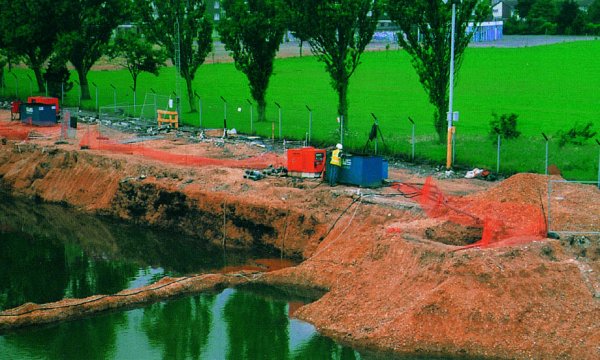So why isn't bioremediation immediately feasible?
-
Many organic pollutants are extremely toxic, even to microbial populations. It has been a challenge for researches to identify (it is possible to genetically engineer organisms to withstand the toxicity; however, there are environmental policy concerns to this approach that will be talked about later) microorganisms that can withstand the toxicity of sites that contain multiple contaminants.
-
Many of the sites that are most in need of cleanup are those that contain multiple pollutants. It is exactly these sites that are hardest to approach from a bioremediation standpoint.
-
Many organic pollutants remain inaccessible to microbes because they are insoluble in soil. Some new lines of research propose to incorporate biosurfactants into bioremediation, which are essentially detergents that can break apart the hydrophobic bonds that hold pollutants together. This allows the microbes to acceess to the pollutants for degradation.
-
There is also insufficient knowledge of the degradation pathways of many compounds. Many pollutants are not known to be degraded by microbes that have been cultured in the lab. Considering that such a small percentage of microbial diversity is culturable using standard protocols, this is no surprise.
Genetically engineered microorganisms: Are they the future of pollution control?
One possible way to expedite the degradation of a wide variety of contaminants is to use 'designer bugs" or genetically engineered microoganisms. These organisms are manipulated in the lab to exploit more eficient or new metabolic pathways to improve the organism's ability to degrade pollutants. The generation of microbes that can detoxify multiple pollutants and is able to survive in that type of ecological environment is a major leap forward for the feasiblity of bioremediation. These designer organisms are not just some futuristic fantasy. Genetically engineered microoganisms (GEMs) are already undergoing lab tests, rather successfully too. Organisms that can degrade a suite of organic pollutants have been engineered in the lab. And, under lab condidtions, they are fufilling their promise by successfully degrading many pollutants. But what happens when these GEMs are released into the environment?
Some environmental policy concerns over the introduction of GEMs into the environment
-
Containment: The containment of GEMs once they are released into the environment is perhaps the biggest concern of the EPA and DOE (the major governement regulatory agencies over bioremediation research and policy). To date, the DOE has been extremely reluctant to introduce GEMs into the environment, even in limited field testing. The main concern is that the GEMs will survive and proliferate well after a polluted site has been decontaminated, eventually outcompeting naturally-occurring microbes and spreading to new areas.
-
Horizontal gene transfer: This is just a fancy way of saying that GEMs may transfer their designer genes into other species of bacteria. This can upset the ecological balance by allowing new bacterial species to thrive in previously inhospitable environments. The ecological ramifications are not well classified, but that only heightens the concern.
Some recent research has been focused on how GEMs might be contained if they were to be released into the environment. GEMs can be engineered to contain suicide genes that would regulate cell survival based on the concentration of pollutants in the environment. Basically, once pollution falls below a detectable amount, the bacterial cells would express the suicide gene, causing the cell to die. With any gene system, however, there is the possibility of inactivating mutations. Over time, bacterial cells that are able to evade the suicide containment system would thrive, leaving us with the original problem. To overcome this, researchers have proposed double containments systems, essentially creating a failsafe mechanism to counter possible mutations. Although this would reduce the chances of bacteria evading the containment systems, it is immpossible to reduce the chance to zero based on the statisitcal probablity of genetic mutations. Although, future systems may provide an acceptable level of control.
Some lasting thoughts ...
-
Is the immediate pollution problem more pressing than the undetermined impacts of releasing GEMs?
-
Are designer bugs really the answer? Or is this approach doomed to fail because it is too 'top down'? Would it be more ecologically sound to cultivate organisms that are naturally able to survive in polluted areas and enhance their ability to degrade pollutants through non-genetic meas (i.e. adding more carbon sources or biosurfactants)?
-
How might this technology (GEMs) be transfered to developing countries considering intellectual property issues?
References
Debarati, P., Pandey, G., Pandey, J., and R. Jain. 2005. Accessing microbial diversity for bioremediation and environmental restoration. Trends in Biotechnology, Vol. 23. p. 135-142.
Zwillich, T. 2000. A Tentative comeback for Bioremediation. Science, New Series, Vol. 289. p. 2266-2267.
